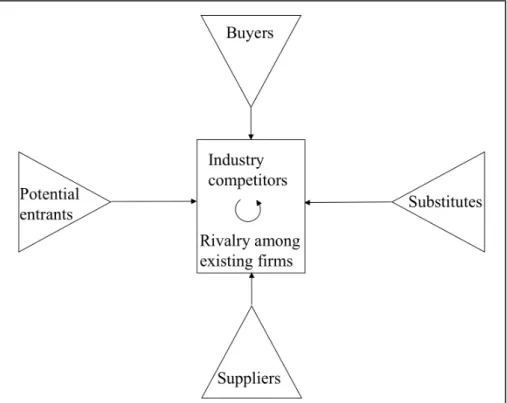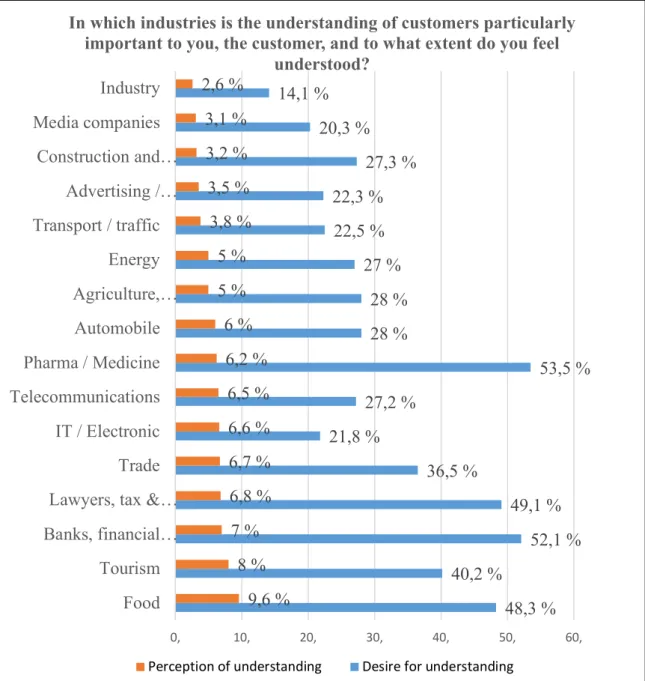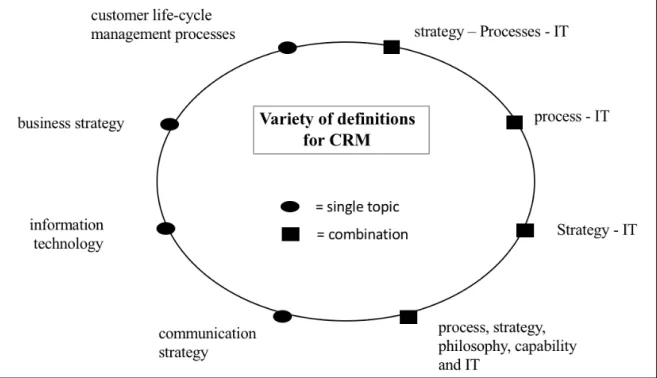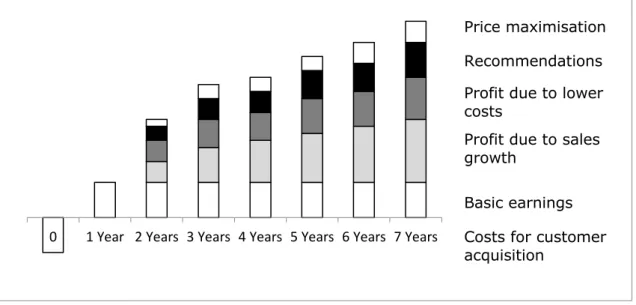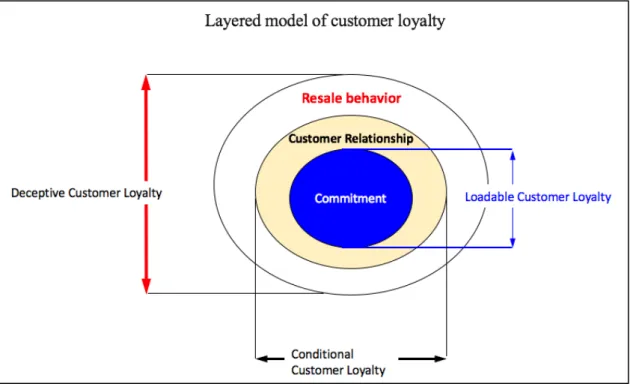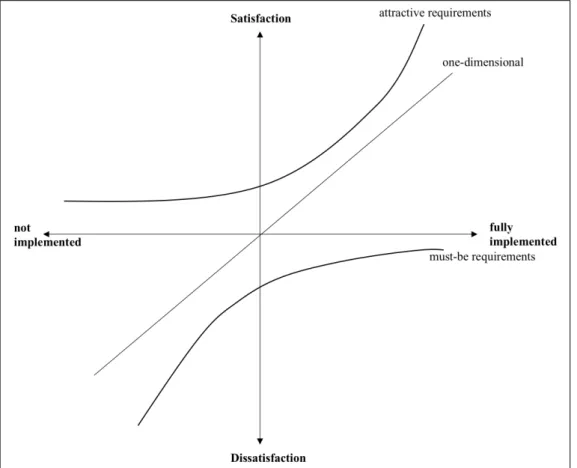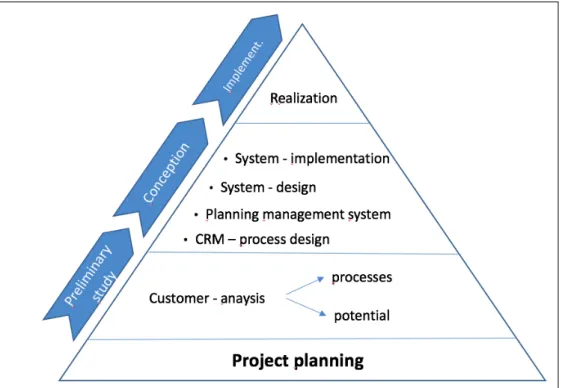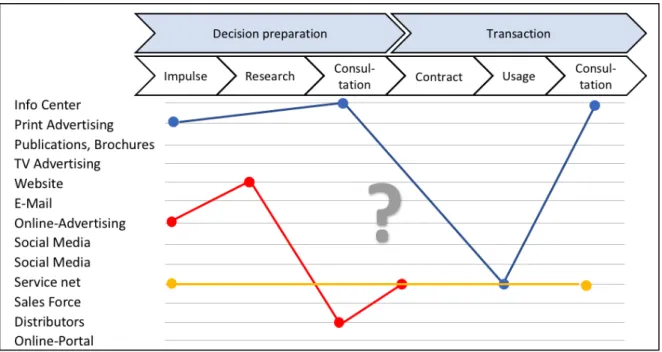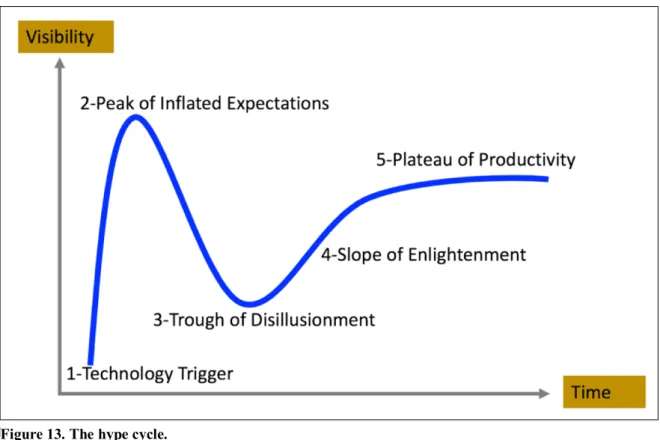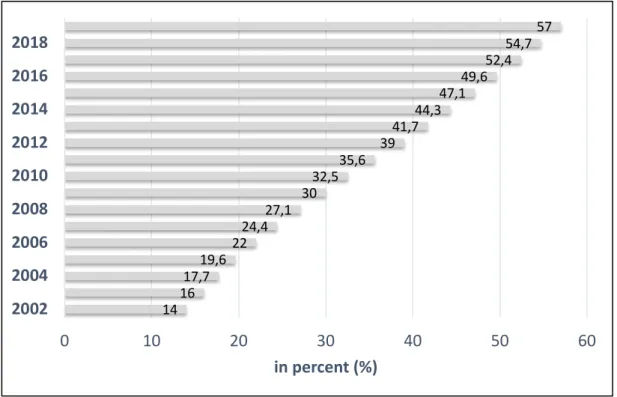University of Sopron - Alexandre Lamfalussy Faculty of Economics
The perception of customer relationship management by customers versus managers as
a critical success factor.
DOCTORAL DISSERTATION
Supervisor:
Univ. Prof. Dr. Markus Mau
Erwin Schlögl B.A., M.A.
Sopron, 2021
CRM - The equal importance of human elements, processes and technologies as a prerequisite for success in a constantly changing environment.
Dissertation to obtain a PhD degree Written by:
Erwin Schlögl, B.A., M.A.
Prepared by the University of Sopron
Széchenyi István Doctoral School of Business Economics and Management Joint Cross-Border PhD Program
Supervisor: Univ. Prof. Dr. Markus Mau
The supervisor(s) has recommended the evaluation of the dissertation be accepted: yes / no _________________________________supervisor signature
Date of comprehensive exam: 2020 year 02 month 11 day Comprehensive exam result __________ %
The evaluation has been recommended for approval by the reviewers (yes/no)
1. judge: Dr. ____________________________ yes/no _____________________
(signature) 2. judge: Dr. ____________________________yes/no _____________________
(signature) Result of the public dissertation defence: ____________ %
Sopron, 20____ year __________________ month _____ day
_____________________
Chairperson of the Judging Committee
Qualification of the PhD degree: _______________________
UDHC Chairperson: _______________________
Table of Contents
1. INTRODUCTION 6
1.1 DESCRIPTION OF THE CURRENT SITUATION 6
1.2 OBJECTIVE OF THESIS 7
1.3 RESEARCH METHODOLOGY 8
1.4 STRUCTURE OF THESIS 9
2. CHALLENGES FOR ORGANISATIONS DUE TO ONGOING CHANGES 11
2.1 CHANGES IN TECHNOLOGY 13
2.2 CHANGES ON THE MARKETS 16
2.3 CHANGES IN CUSTOMER BEHAVIOUR 20
3. CUSTOMER RELATIONSHIP MANAGEMENT 24
3.1 CRM DEVELOPMENT 27
3.2 DEFINITIONS AND SEGMENTATION 28
3.3 CHALLENGES WITH CRM 33
4. HUMAN INTERACTION IN CUSTOMER RELATIONSHIPS 35
4.1 CUSTOMER IMPORTANCE 35
4.1.1 Valuable long-term customer relationships 37
4.1.2 Characteristics of customer behaviour 44
4.1.3 Customer expectations 46
4.1.4 Customer service setup differentiated/segmentation 49
4.2 MANAGEMENT INVOLVEMENT 52
4.2.1 Executive board involvement 52
4.2.2 Project management skills for CRM projects 55
4.2.3 Consider change management tasks 58
4.2.4 Corporate culture supports customer orientation 60
4.3 EMPLOYEE – THE INTERFACE TO THE CUSTOMER 61
4.3.1 Direct contact with the customer 62
4.3.2 Employee satisfaction 63
4.3.3 Increase commitment with continuous training 65 5. IMPLEMENTATION OF CUSTOMER-ORIENTED PROCESSES 66
5.1 REVIEW OF EXISTING PROCESSES 67
5.2 CUSTOMER CENTRICITY IN PROCESS SETUP 71
5.3 CROSS-FUNCTIONAL COLLABORATION 73
5.4 CHANNEL COMMUNICATION 75
6. TECHNOLOGY SUPPORT FOR CUSTOMER-ORIENTED SOLUTIONS 79
6.1 ADVANCEMENTS IN TECHNOLOGY 83
6.2 SOFTWARE SUPPORT 86
6.3 DATA COLLECTION 88
7. EMPIRICAL STUDY 89
7.1 METHODOLOGY 89
7.1.1 Objectives of the research 90
7.1.2 Derived areas from literature 90
7.1.3 Development of research questions 94
7.1.4 Determining the sample 95
7.1.5 Determine the data collection method 98
7.1.6 Data analysis 98
7.2 RESEARCH PROCESS 99
7.2.1 Preparation of the questionnaire 99
7.2.2 Contact with participating companies 101
7.2.3 Data collection 102
7.2.4 Process of data analysis 103
7.3 RESULTS 103
7.3.1 Sociodemographic facts 104
7.3.2 Deviation in overall median and the quadrants 107
7.3.3 Deviation of the two cohorts 108
7.3.4 Analysis of sociodemographic subgroups 122
7.4 FINDINGS 129
7.4.1 Answering the research questions 129
7.4.2 Discussions 132
7.4.3 Recommendations for management 134
7.4.4 Limitations and future research 138
8. CONCLUSION 140
BIBLIOGRAPHY 146
APPENDICES 160
APPENDIX 1: QUESTIONNAIRE CUSTOMER 160
APPENDIX 2: MANAGEMENT QUESTIONNAIRE 163
List of Tables
TABLE 1.CRM FOCUS OF DIFFERENT AUTHORS. ... 32
TABLE 2.OVERVIEW OF THE SURVEY PARTICIPANTS. ... 104
TABLE 3.QUADRANT SIGNIFICANCE ... 108
TABLE 4.MANAGEMENT VS. CUSTOMER MEDIAN. ... 109
TABLE 5.DEVIATIONS BETWEEN POSITIVE CUSTOMER AND MANAGEMENT PERSPECTIVES. ... 111
TABLE 6.DEVIATIONS BETWEEN NEGATIVE CUSTOMER AND MANAGEMENT PERSPECTIVES. ... 112
TABLE 7.DEVIATIONS BETWEEN NEUTRAL CUSTOMER AND MANAGEMENT PERSPECTIVES. ... 113
TABLE 8.CUSTOMER TREATMENT. ... 118
TABLE 9.DEVIATIONS BY AGE. ... 122
TABLE 10.DISTRIBUTION OF PRIVATE AND BUSINESS PARTICIPANTS. ... 128
TABLE 11.PRIVATE AND BUSINESS DEVIATIONS. ... 128
TABLE 12.CUSTOMER RECOMMENDATIONS. ... 135
TABLE 13.PEOPLE RECOMMENDATIONS: MANAGEMENT. ... 135
TABLE 14.PEOPLE RECOMMENDATIONS: EMPLOYEES. ... 136
TABLE 15.TECHNOLOGY RECOMMENDATIONS. ... 137
TABLE 16.PROCESS RECOMMENDATIONS. ... 137
List of Figures
FIGURE 1.FORCES THAT ARE DRIVING THE COMPETITION IN INDUSTRY. ... 12
FIGURE 2.EMPATHY REPORT 2016. ... 22
FIGURE 3.RELATIONSHIP DEFINITIONS. ... 26
FIGURE 4.VARIETY OF CRM DEFINITIONS ... 29
FIGURE 5.DETERMINING THE PROFITABILITY OF CUSTOMER RETENTION. ... 38
FIGURE 6.THE PROFITABILITY OF LOYAL CUSTOMERS. ... 38
FIGURE 7.MODEL OF CUSTOMER LOYALTY. ... 42
FIGURE 8.CUSTOMER SATISFACTION MODEL. ... 48
FIGURE 9.PROJECT PLANNING PHASES. ... 56
FIGURE 10.STRUCTURED IMPLEMENTATION PROCESS. ... 57
FIGURE 11.STRUCTURED APPROACH TO PROCESS IMPROVEMENT. ... 68
FIGURE 12.THE CUSTOMER JOURNEY. ... 76
FIGURE 13.THE HYPE CYCLE. ... 80
FIGURE 14.HOUSEHOLDS WITH INTERNET ACCESS (2002–2019). ... 81
FIGURE 15.CRM TOUCHPOINTS. ... 85
FIGURE 16.THE BALANCED SCORECARD. ... 92
FIGURE 17. SUCCESSFUL CRM AND THE PPTC APPROACH. ... 94
FIGURE 18.EMPATHY REPORT 2016. ... 96
FIGURE 19.DATA COLLECTION SCHEDULE. ... 102
FIGURE 20.COMPANY-SPECIFIC AGE DISTRIBUTION. ... 105
FIGURE 21.COHORT-SPECIFIC AGE DISTRIBUTION. ... 106
FIGURE 22.GENDER-SPECIFIC AGE DISTRIBUTION. ... 106
FIGURE 23.OVERALL QUADRANT MEDIAN. ... 107
FIGURE 24.THE COMPARISON OF POSITIVE RESPONSES. ... 110
FIGURE 25.THE COMPARISON OF NEGATIVE RESPONSES. ... 111
FIGURE 26.THE COMPARISON OF NEUTRAL RESPONSES. ... 113
FIGURE 27.THE COMPARISON OF ALL RESPONSES. ... 114
FIGURE 28.CUSTOMER TREATMENT. ... 117
FIGURE 29.CUSTOMER LOYALTY. ... 119
FIGURE 30.CUSTOMER SATISFACTION. ... 120
FIGURE 31.CUSTOMER SELF-SERVICE... 121
FIGURE 32.AGE DEVIATIONS. ... 123
FIGURE 33.AGE DEVIATIONS IN QUESTIONS FROM QUADRANT ONE. ... 124
FIGURE 34.AGE DEVIATIONS IN QUESTIONS FROM QUADRANT TWO. ... 125
FIGURE 35.COMPANY-SPECIFIC GENDER DISTRIBUTION. ... 126
FIGURE 36.GENDER DEVIATION - CUSTOMER TREATMENT. ... 127
List of Abbreviations
B2B Business-to-Business
B2C Business-to-Consumer
BSC Business Scorecard
CRM Customer Relationship Management
DSG Datenschutzgesetz
ERP Enterprise Resource Planning
FOG Forschungsorganisationsgesetz
GDPR General Data Protection Regulation
IT Information Technology
LTV Lifetime Value
mCRM Mobile CRM
MMS Multimedia Messaging Service
NPV Net Present Value
OECD Organization for Economic Cooperation
RFM Recency, Frequency and Monetary
SFA Sales Force Automation
SPSS Statistical Package for the Social Sciences
SMS Short Messaging Service
TKG Telekommunikationsgesetz
USP Unique Selling Proposition
WAP Wireless Application Protocoll
Abstract
:Introduction: Considerable changes in the past, ongoing developments in the present and uncertain future prospects pose significant challenges to companies as well as customers.
Companies need to be particularly responsive to changes that occur in the markets, changes coming from developments in technology and in the status and behaviour of customers. In this changing environment, companies value the importance of long-term customer relationships and consider it a great opportunity to achieve stability and predictability.
Customer Relationship Management (CRM) promises support. In this context, CRM must not be understood only as a software installation. CRM is a strategic instrument that aligns a company with its customers. Although CRM has been developed since the 1990s and implementations are widespread among companies across all sectors, the fail rate is still very high at up to 75%.
Objectives: Researchers and academics investigated in success factors to mitigate the risk of failed CRM projects, but the fail rates did not drop considerably. Most CRM studies have mainly focused on internal company processes, neglecting customer interests. The aim of this study is to investigate CRM issues, with a focus on the customer´s perspective, to find out if there are misunderstandings between company and customer perceptions. Results should provide practical added value for the benefit of the customer and subsequently also for the health of the company.
Research Questions:
1. Are the focal points of the investigation with customer, people (management and employees) and technology recognised as important topics from customers and managers?
2. Is there agreement or discrepancy between customer perception and management perception?
3. How can potential differences be explained using subgroup analyses?
4. What immediate measures can be derived from the study?
Methods: The first part of the study concerned literary research. Then a survey was administered to customers and management of five different brands of car dealership. The survey included a set of questions split into four topics (process, people, technology and customer). The purpose of this approach was to determine deviations in answers from management and customers.
Results: There is no one-size-fits-all or straight forward explanation why so many projects fail. A holistic approach (overall median) does not reveal significant difference, but
statistical tendencies are recognised. Additional analysis of subgroups indicate that age and gender effects could have an impact on customer relationships as well as a differentiation in business customers and private customers. Findings from the survey and the conversations and observations made during the survey were listed in a structured way and can serve as suggestions for management.
Keywords:
CRM, CRM projects, fail rates, customer retention, customer loyalty
1. Introduction
The marketing mix was an important guideline in the marketing literature for companies for a long period. The realization that neither the past nor the future of a customer relationship was considered in the marketing mix initiated a development away from transaction marketing towards long-term relationships. The assumption that long-term customer relationships are more promising, motivates companies to investigate Customer Relationship Management (CRM) intensively. The main focus of CRM is on the customer. However, the importance of customers for business success is not a new insight. The principles for customer relationships have been the same for former grocery shops. Grocers around the corner knew their own customers personally and tried to respond to their wishes (Elbeltagi et al., 2014, pp. 129–130).
Relationship management changed considerably in the 1990s when companies rediscovered the importance of customers and the relationship with the customer (Zineldin, 2006, p. 431).
Unfortunately, Customers are still not getting the attention they are promised through CRM.
The “C” in CRM makes an explicit appeal in this regard (Kale, 2004, p.44).
1.1 Description of the current situation
A CRM implementation confronts companies with large and diverse challenges. Fail rates at a consistently high level (up to 75%) prove that the implementation of CRM requires appropriate efforts. Projects can be classified as failed projects, if goals defined at the beginning could not be achieved. Competitive markets demand a lot from companies;
winning and keeping loyal customers is becoming increasingly difficult. Technological developments are further complicating the situation for companies, because products and prices are transparent on a global market. Furthermore, customers are well informed about product descriptions and available services. In such unsettled times, CRM offers a concept that promises to stabilize customer relationships. This assumption is related to a consistent orientation in the company towards the customer. Extensive data collection and the analyses derived with IT support helps companies to proactively identify customer trends and behaviour to offer tailored products and services. However, the promising effects of a CRM initiative cannot hide the fact that many CRM projects still fail. Considerable, sometimes unexpected, costs and a lack of positive effects have a massive impact on companies that already face difficult times because of highly competitive markets. The fact that it has not
yet been possible to significantly reduce the proportion of failed CRM projects appeals particularly to researchers in the field (Farhan et al. 2018, pp. 398).
Unfortunately, CRM initiatives often end up unsuccessful or even with a loss at the bottom- line. Sometimes, CRM projects even end up in disaster (Rigby et al., 2002, p. 103).
Customer relationships require different approaches in B2C compared to B2B. Literary research provides more insights into customer relationships with consumers rather than with organisations. Private customers generally take less time to make a purchase decision than companies do. In companies, decisions are analysed and evaluated objectively before a decision is made, whereas emotional aspects play an important role for private customers.
While purchasing decisions for companies are usually made within a defined group of people, decisions for private customers are made by individuals. It is important in terms of customer management that corporate customers, unlike private customers, tend to maintain long-term customer relationships (Foscht, Swoboda, 2011, p. 278). The focus of this thesis is on B2C business relationships.
1.2 Objective of thesis
Extensive literature on the topic of CRM provides an insight into the most diverse approaches to the topic. Despite many success factors identified by researchers and academics, the majority of CRM projects are still not successfully implemented. The facts give a clear answer with fail rates of up to 75%.
Company investments in a customer-oriented setup and the related technology require careful evaluation to ensure the costs are covered by corresponding added value, such as long-term customer relationships.
While there is a great deal of literature on various approaches to the topic of CRM project implementation, success factors and failed projects, there is rather little reported on differences in perception between customers and companies on the topic of shaping the customer relationship.
The primary aim of this study is to question whether clients and companies have a common understanding, particularly with regards to upfront defined areas. There is a wide range of success factors that have been identified by researchers and academics for successful CRM
projects. The knowledge acquired has not yet led to any significant improvements in the success rate. It is not the aim of this investigation to question other success factors or to define implementation steps. Technical errors in the implementation of a CRM initiative are also not examined.
In the empirical part, the study starts with the implementation of a survey. The survey is targeted at customers and management and compares the responses per company. This approach implies a natural imbalance in the number of participants in the two cohorts.
Despite this imbalance of participants, the objective is to gain scientific knowledge. The inductive approach will be used to seek new insights that can be used in further research in specific other targeted cohorts.
For this investigation, the car industry and especially car dealers that are classified in the premium segment were used. The intention of this selection was to observe customer behaviour within one segment but with different brands.
Investigations on the perceptions of customers as well as companies on the same topics shall contribute to implementing sustainable CRM initiatives. The investigation topics derived from literature are people, processes and technology. The customer was chosen as the fourth main topic due to their importance.
1.3 Research methodology
The present study employed a quantitative approach to investigate at different levels. One part involved collecting feedback on the critical factors identified upfront (process, people and technology). In addition, the survey was conducted with two different groups, the customers and the management.
The research process forms the basis for evaluating the understanding of customers and companies in regards to the customer relationship. With this approach, the following research questions will be answered.
1. Are the focal points of the investigation, customers, people (management and employees) and technology, recognised as important topics by customers and managers?
2. Is there agreement or a discrepancy between customer perception and management perception?
3. How can potential differences be explained using subgroup analyses?
4. What immediate measures can be derived from the study?
A survey has been conducted within the automotive industry. This industry was selected based upon the fact that their customers not only have a lot of consultation meetings and interactions before purchase, but also subsequent services or aftercare requirements. Long- term customer relationships are of significant importance in this industry. The subjects of this study consisted of participants from five car dealerships positioned in the premium segment.
1.4 Structure of thesis
The procedure for the study adheres to the following structure with six main sections:
Factors influencing the economic activities of companies are manifold. In addition, there are increasingly permanent changes that require a high degree of willingness to adapt on the part of companies. Change flows have an impact on customer relationships and are described in Chapter Two.
CRM raises expectations and increases competitive pressure on companies to achieve sustainable success in times of change. The development of CRM is described in Chapter Three. Strengths, weaknesses and fundamental challenges are discussed.
In the next step, four main topics are derived from the abundance of success factors for a successful CRM introduction. These four main topics are dealt with in separate chapters (Chapter Four to Chapter Seven). These topics also provide the framework for the empirical study. In the Chapters Four to Seven, the influence of people, processes and technology on successful CRM implementations is elaborated. The customer occupies an exceptional position in this regard. Therefore, customers are the fourth element in the research. People, processes, technology and customers subsequently form the basic areas of the questions addressed to the target persons in the empircal section of this study. The development,
implementation and analysis of the survey is then detailed. Findings from analysis are documented, research questions are answered and recommendations for action are derived.
Finally, the essential points of the thesis are captured in the conclusion chapter. The main points are summarised and the most important findings for further research are mentioned.
2. Challenges for organisations due to ongoing changes
Companies are in constant competition with others. The challenge is to find solutions that allow the company to survive against the competition. Successful business relationships are difficult to maintain over time. Rapid technological progress in particular creates transparency and thus comparability in the market. With CRM, companies try to create a competitive advantage by maintaining long-term customer relationships. When the company in question is an e-business, it is even more difficult to maintain long-term customer relationships. This makes it all the more important to successfully implement CRM in this area in the form of Electronic Customer Relationship Management (eCRM). (Kimiloglu, Zarah, 2009, p. 246).
The five forces of competition illustrated in Figure 1. have been defined by Michael Porter.
Porter published the Five Forces design in the Harvard Business Review 1979 (Bruijl, 2018, p. 1). New market entrants are one of the threats highlighted. They can have an impact on prices; these will probably decrease to compete with newcomers to the market. Barriers can exist or be created to make it difficult for new participants to enter. Economies of scale pose problems for newer businesses who are disadvantaged by small quantities of product.
Another barrier is the differentiation of the product. Existing firms have an advantage due to their already established products. Customers are not likely to revert from one brand of product to another less familiar product without some persuasion. The customer may incur switching costs that deter them from dealing with newer businesses. Depending on the industry, new participants in the market are often required to secure large financial investments before establishing themselves – yet another factor working against newcomers.
There are countless disadvantages that new entrants may encounter that are independent of scale, like the unavailability of patents, or perhaps established companies already own the best industrial locations. Government can create barriers via the limitations on licences in some areas (Porter, 1980, pp. 3-13).
Figure 1. Forces that are driving the competition in industry.
Source: Porter, 1980, p. 4, own figure.
The next threat to consider is the impact of existing competitors. Competition is defined by pricing, product innovation and the extent of customer service. Companies are in permanent competition with each other. If companies constantly undercut or try to outbid other companies through various activities, this can lead to an entire industry suffering.
Substitution of products is another risk and is the third of the five forces described by Porter.
The next competition threat is the bargaining power coming from suppliers. If suppliers are very powerful, they might either increase prices or reduce quality of products. In such sectors, there is a danger that excessive costs in procurement will lead to reduced earnings in sales. Finally the power of the buyer is a threat for companies. When customers take a position of power in a market situation, they get bargaining power with which they can demand better service or lower prices. Gaining information about products or pricing can lead to more bargaining power. (Porter, 1980, pp. 17–27).
In the environment of a company, the intensity of the five forces has an impact on the profitability of a company. This is relevant in industries where a company is competing against others. Consequently, this situation reveals what possibilities a company has when defining a strategy. Restrictions need to be considered for the strategy. The forces outside the industry have an impact on all companies within an industry. Depending on how
intensely the five forces act on a company as a whole, there may exist more or fewer opportunities to generate profit (Porter, 1980, p. 3). Companies are always in competition, the extent of which depends on various influences. Companies should therefore examine the influences of the five forces in order to accurately assess their own opportunities and possibilities accordingly. In this way, the company can identify its own strengths and weaknesses in the competitive environment.
The five forces show that competition in a broader sense does not only refer to competitors.
These five forces represent a competitive situation for companies. Depending on how exposed a company is to the various forces, there are more or less opportunities to plan for strategic success. The forces must always be considered in their entirety. Even if one of these dangers is not relevant, it may be that one or more other forces are all the more dominant, which in turn reduces the company’s chance of success (Porter, 1980, p. 3).
With barriers, sellers can make it difficult for customers to switch to other suppliers, but this approach can have a negative impact on the customer relationship. To avoid this lock-in function, companies tend to try to retain customers by generating benefits for customers through loyalty programmes or by offering service benefits, or reduced prices (Slater/Olsen, 2002, p. 19).
Many economists are asking themselves whether Porter's model is still valid as it has not been further developed since 1979. Particularly critical is seen in the model, that a static market structure is assumed and small and medium-sized enterprises are valued with the same model as large enterprises. Other strategic models like the RBV (resource-based view) or the blue ocean strategy as well as for example the delta model have been developed and can be considered in addition to the model from Porter (Bruijl, 2018, pp. 5-10).
2.1 Changes in technology
The 90s saw the start of digitalised data-keeping. The creation of everyday mobile devices, the ability to store large volumes of personalised data combined with the new technology used to deploy and utilise it lead to new developments on the market. Information from various channels can be linked in real-time. Thus, customer needs can be considered rapidly.
Tendencies are to provide individualised and fast customer service. Digitization is a trend that is independent of the industry and takes place in all processes of a company. The consequences are grave and are often described as the fourth industrial revolution. New
distribution channels are a consequence of the new technology. Sellers are able to communicate more frequently and more directly. This ease of communication influences the customer relationship, and providers need to be prepared to deliver on several channels (multi, omni channel distribution) (Meffert et al., 2019, pp. 72).
Long before the term CRM was created, companies tried to achieve customer satisfaction and build customer relationships. Enhanced technology is supporting the CRM deployment.
Technological developments provide opportunities for companies to maintain individual business relationships with a large number of customers, which was not feasible before. The technological achievements also help to process large amounts of data efficiently and effectively. Nowadays, there is no limitation in storage capacity for collected data. Despite the huge amount of data, analysis can be achieved immediately. Insights derived from data analysis can support companies in adapting products or services to customers’ needs. The constant development and expansion of the technical range of services leads to favourable prices for technical purchasing (Payne, Frow, 2006, p. 136).
Opportunities coming from the technological development of the internet are manifold. Even production concepts like mass customisation and personalisation of products are supported by the internet. Personalisation enables customers to design a product according to their own wants and needs within defined frames. With this approach, a unique product can be created that is quite different from products coming from mass production. It was not possible to implement these processes in the past because of technical restrictions (Pires et al., 2006 p.
945).
There is a danger that CRM software salespeople will increasingly act as CRM consultants.
This will have an impact on the way CRM projects are set up, which will then tend to be IT- focused. Process design and the involvement of people often do not receive the necessary attention afterwards. It can be explained by the fact that CRM has evolved from Sales Force Automation. In this situation, IT has helped considerably in facilitating work through technical support activities like managing reminders for customer calls (Elbeltagi et al., 2014, p. 146).
Finally, Mobile CRM (mCRM) supports customer requirements quickly and easily fulfills customer needs. Basically, mCRM is defined by three main factors: customer loyalty endeavours, customer service and analysis of information. The accessibility of information
and its rapid analysis ensure quick responses to customer enquiries and allow for companies to present offers that are suitable and specific to the customer. Mobile devices create new opportunities for customers, for example, they can easily collect bonus points on customer clubcards (loyalty programmes). Mobile devices provide considerable convenience.
Customers can send technical inquiries, support inquires or requests concerning orders to companies, very flexibly. Another advantage of the mobile service is the on-demand service requests for products. Information sharing is provided permanently and customers are able to get quick and easy feedback. In addition, applications can be installed for more convenience. Areas of application are manifold and range from evaluations of recorded customer data and availability of operation manuals, to reminder functions for important appointments (Holland, Koch, 2015, pp. 95,96).
Despite its many benefits, the introduction of mCRM poses even more challenges for companies than the introduction of a traditional CRM (without internet) already does. Social media integration harbours a considerable risk, as experiences are discussed openly on the Internet and can easily escalate and end up in shit storms (Grässel,Weinberg, 2015, p. 112).
Enhanced technological developments provide new possibilities. This is also an enabler for new market entrants to quickly succeed on the market and endanger existing companies.
Such developments are increasing competition and are forcing well-established companies to encourage new customers and establish long-term customer relationships (Mendoza et al., 2007, p. 915).
Not only are individual companies experiencing changes due to new developments like cloud technology, mobile internet and 3D printing, but even entire industries are feeling the change. The Organization for Economic Cooperation and Development (OECD) sees the promotion of such innovative technologies as a way to create sustainable prosperity.
Developments such as the mobile internet also have an impact on customer behaviour.
Customers are much better connected and able to obtain information any time and anywhere, which is then used specifically to inform their purchase decisions and sales negotiations (Kotler et al., 2017, pp. 45–46).
2.2 Changes on the markets
Reasons for changes on the market are numerous. A main driver of this change is the development of new technology. The technology is now accessible to all and this provides new possibilities. Newcomers on the market are another trigger for changes on the market They get better chances to enter a big market without considering the old established market leaders due to the platforms technology provides. Every newcomer has the chance to start a business right from the beginning on a global market. The global market and the transparency of price and conditions increases the knowledge of customers and expands their awareness of brands, products and prices. Customers share their knowledge and experiences with others. This is supporting the power shift from sellers to customers (Pires et al., 2006 p. 938).
Buyers have experienced an increase in market power because of technological developments and their impacts. This opens up significantly more opportunities for buyers to obtain information. The rise in knowledge strengthens their negotiating power. Marketing strategies need to be reviewed and management needs to prepare for new developments on the markets. Customer behaviour is changing and marketers need to adapt rapidly. The continued technical development is a huge challenge and seems to further strengthen the customer’s role (Pires et al., 2006 p. 946).
In regards to history and the progression of industry, it has become clear that companies constantly need to adapt to the demands of the market in order to remain successfull. After the Second World War, it was evident that companies focused mainly on products and production and not on customers. This was the situation in the 1950s and 1960s. At this time, demand exceeded the supply and this moulded companies that prioritised production optimization and delivering on time. This was the beginning of the transformation from a seller market to a buyer market (Rothlauf, 2014, p. 40).
The situation changed slightly in the 1970s as competition increased, and the power converted further over to the customer. As a consequence, customers demanded better services and individual or personalised treatment. Market segmentation was necessary in the 70s and target groups were analysed to concentrate on specific customer groups.
Competition became fiercer in the 1980s as new suppliers established themselves and products became more similar. As a countermeasure for this challenge, companies increased
their efforts to generate an Unique Selling Proposition (USP). In the 1990s companies rediscovered the importance of the customer and started with customer focused activities that tailored services to fulfil individual customer requirements (Bruhn, 2016, pp. 4–6).
The speed of change has increased in social environments and companies need to quickly respond to new requirements. Starting with the 2000s complexity has increased and companies need to consider their own competitive advantage as well as other factors like the dynamic market situation. Continuous improvements and adjustments of management decisions are necessary (Meffert et al., 2019, pp. 7–9).
The scarcity of products ended in the middle of the twentieth century, due to the beginning of mass production and the appearance of new competitors. Due to this upscale in industry, the quality of the sales process and the relationship between seller and buyer got somehow lost. Customers were reduced to a kind of an account number with considerable consequences. Vendors lost contact with their customers and subsequently ignored the customers’ needs. Nowadays, there is a tendency for companies to revert back to the more personalised method of service. Vendors are competing with others to find and maintain long-term customer relationships and formulate an understanding of customer requirments and behaviour (Chen, Popovich, 2003, p. 672).
The situation in the markets forced suppliers to review their business strategy in regards to customers and adapt to cater for customer requirements. The power shift from seller to buyer was clearly visible (Rothlauf, 2014, p. 40). Companies had to realise that it was more difficult achieving differentiation from competition via products, other means had to be utilised to attract and keep customers. Hence, an improved customer service and the ability to react rapidly to changing customer requirements were identified as USP that would attract customers and build long-term customer relationships (Helmke, Uebel, 2013, p. 5).
The fact that the market now focused on the requirements of the customer meant that other changes were necessary. Methods of marketing had to be adapted, from transaction marketing to relationship marketing. Companies made an effort to engage with customers on a long-term basis to ensure their business relationship is a long and prosperous one rather than a one-off transaction. Long-term customer relationships require continuous monitoring of customer requirements. A consequence of this development is a paradigm shift from product to customer orientation (Bruhn, 2007, p. 6f.).
In a market situation where the seller is more powerful than the buyer (seller´s market), vendors are in a position to determine the terms and conditions of contracts. They may dictate, for example, price or delivery conditions. In this case, the customer would have to accept the terms of the contract defined by the seller due to the lack of alternatives offered.
In a market situation where supply exceeds demand, customers have a stronger bargaining position and can therefore have more influence on the terms and conditions of contracts (Bartels, 2012, p. 2).
Global political developments have a major impact on the markets. Political changes opened the door to market capitalism in a global context. From the political perspective, Eastern Europe and the Soviet Union dissolved, while China and India opened their markets. New opportunities arose and companies responded to evolving market needs where buying habits are no longer limited to the local or national market (Belk, 2007, p. 147).
Furthermore, globalisation is intensifying the competition with the emergence of new market participants. Markets are becoming largely saturated. Product life cycles are becoming constantly shorter and companies have to decide quickly, sometimes without any market research, in order to have products ready for customer needs. Good products are not the only guarantee for success, because of fast changing markets. Market needs might have changed in the time it takes to produce a quality product, or product substitutes are suddenly available with considerable influence on the success of a company (Essinger, 2001 p. 1).
Historical experience reveals a change from transition marketing to relationship marketing with an increasingly stronger focus on the customer. Increased competition forces companies to build long-term relationships and to pay careful attention to the wishes and needs of customers (Bruhn, 2016, pp. 7-8).
The challenges in highly competitive markets are constantly increasing. New entrants increase competition. In addition, overcapacity as well as new competition from global participants is influencing business success considerably and strengthening the position of the customers. A rapid drop in prices is an inevitable consequence. Companies try to succeed with countervailing activities like cost reduction, pioneering innovations or improving profiles and customer loyalty schemes. The economic situation of the customers has a direct impact on the suppliers, because a rise in unemployment triggers uncertainty among the sellers (Belz, Bieger, 2006, pp. 61–62).
Since market changes are unavoidable, companies need to adapt accordingly. Thorough planning and profitability projection is necessary. Product and production orientation are no longer enough to be successful in the market. It is more important to focus on profitable customers and try to fulfil customer requirements. Instead of mass production, companies need to follow their customers and adjust processes rapidly according customer needs (Kehl
& Rudolph, 2001, p. 89).
Companies need to react to the growing complexity of the market environment. Quick responses to developments on the market are mandatory, because customers are changing purchasing patterns often and abruptly. A further challenge is posed by the fact that products are imitated quickly, which results in innovations not being as successful or coveted for as anticipated. Product imitations are the reason why products are similar. Differentiation in terms of quality or price is nearly impossible because customers take it as a given that they can purchase products of good quality for the best available price (Essinger, 2001 p. 37).
Companies need to understand that a brand is no longer under the control of just one company. Due to the shift in the balance of power, customers have much more influence on how products and brands develop (Kreutzer, 2015, p. 12).
2.3 Changes in customer behaviour
Changes in the market sometimes result from changes in terms of the customer; these may be related to demographic and behavioural facts. Demographic changes can be recognized by the aging of the population. The population is older partially because the birth rate is falling. In addition, immigration, as seen in Europe, leads to a diversity of cultures.
Individual consideration of consumers is necessary, because households are made up of an ever expanding variety of demographics. An obvious and extreme alteration in consumer behaviour is that of women. 60% of women are now in full time work, even if they have children (Kumar, Reinartz, 2012, pp. 6–7).
Many different social developments are accelerating changes. Size and composition of households are changing because of the trend of more single households. In addition, the changed role of women in society is having an effect on buying patterns. Furthermore, customers experience a permanent lack of time and therefore want to buy on demand and appreciate top services from companies that save them time (Berger, 2015, p. 119).
The transition of power in the markets is not a new situation. Historically, there have always been attempts by customers, but also sellers, to achieve a stronger negotiating position (Pires et al., 2006 p. 938).
There was a big change in customer behaviour at the beginning of the 21st century with huge implications concerning the business dynamic and trade. Since then, customers do not act in predictable ways, but in a manner that is based on various aspects like emotions, prices, or their geographic location at the time of shopping. This unpredictable behaviour makes it increasingly difficult for suppliers to make a segmentation in the market and prepare a communication concept with specific target groups (David, Hilpert, 2016, p. 189).
Changes in the diversity and behaviour of customers are difficult to manage. This is also an argument for a strategic CRM implementation. Diversity itself is changing in nearly all industrialized nations. This changed situation leads to changed market participants and thus changed requirements from the market. Suppliers are forced to respond to the needs of new markets. Customers are more time sensitive, they expect twenty-four-seven support.
Communication and interaction between company and customer must be short and efficient.
Furthermore, customers are expecting top service and do not accept bad service quality. The reason for that is the development of the internet and the growth of consumer knowledge.
Customers are well informed and know what they can expect for their money. Unfortunately, there is a trend of disloyalty recognised in the modern customer (Kumar, Reinartz, 2012, pp.
6–10).
There is another trend observed called multi-option society. Due to the wide range of products and services offered, customers are granted a multitude of options to choose from.
This is on the one hand a comfortable position for customers – a kind of opportunity for self- realisation – but on the other hand it creates an attitude of cognitive dissonance on the customer side. The large selection of options puts additional pressure on companies when it comes down to improving relationships with existing customers.
It is evident that life is getting faster and people are longing for a deceleration. A kind of non-stop lifestyle is predominant, however, and induces new approaches and strategies for achieving sustainable success from the vendors point of view (Belz, Bieger, 2006, pp. 59–
60).
Environmental influences also inspire customer behaviour changes and companies have to react to these accordingly. When considering the impact of environmental influences on the four Ps (product, price, place, promotion) the following issues must be addressed and incorporated into a company’s marketing strategy. Product development is becoming more complex because the composition of materials is significant in terms of the footprint they leave behind. Particular attention is paid to the product packaging, which should be biodegradable. The price calculation must take into account regulations regarding environmental protection. Companies point out the environmentally friendly aspects in their services. Customers are willing to spend more money on environmentally friendly products.
The location of the company's buildings also has an impact on the environment and thus on the attention paid to customers. The aim is therefore to produce close to the sales markets.
Advertising is increasingly shifting from the print version to the online version. This saves paper production, which benefits the environment and ensures sustainability (Kotler, 2011, p. 133).
However, this study intends to critically examine customer perceptions while exploring what the companies belive in regards to their customer relationships. Figure 2 details the results of a customer survey that was carried out in Austria in 2016 which identifies deviations.
Figure 2. Empathy report 2016.
Source: Reference Marketagent, Strategie Austria, Statista, 2016
In the survey, large differences can be identified between the customer’s desire for a more customer orientated approach and the actual customer orientation. The evaluation proves that there are definitely differences in the various sectors with regard to the customer's desire for more attention. What is sobering is that, according to this survey, the customer’s perception of the industries’ understanding of them is consistently very low. In any case, the percentage describing the perceived customer orientation is always below 10%. A look at the data in the automotive industry shows that 28% of customers would like to see the
48,3 % 40,2 %
52,1 % 49,1 % 36,5 %
21,8 % 27,2 %
53,5 % 28 %
28 % 27 % 22,5 % 22,3 %
27,3 % 20,3 % 14,1 %
9,6 % 8 % 7 % 6,8 % 6,7 % 6,6 % 6,5 % 6,2 % 6 % 5 % 5 % 3,8 % 3,5 % 3,2 % 3,1 % 2,6 %
0, 10, 20, 30, 40, 50, 60,
Food Tourism Banks, financial…
Lawyers, tax &…
Trade IT / Electronic Telecommunications Pharma / Medicine Automobile Agriculture,…
Energy Transport / traffic
Advertising /…
Construction and…
Media companies Industry
In which industries is the understanding of customers particularly important to you, the customer, and to what extent do you feel
understood?
Perception of understanding Desire for understanding
industry become more customer orientated, which contrasts with the 6% who perceive adequate customer orientation. There is a very large potential for companies to improve as customer orientation seems to be far from being fulfilled (Bruhn, 2016, pp. 4–6).
Customer orientation requires companies to anticipate what their customer really needs.
Companies need to react and provide quality answers, solutions and services that exceed expectations. This will help them establish a one-to-one customer relationship. Close customer relationships are success factors for companies and therefore require appropriate attention (Peppers, Rogers, 2001, p. 47).
3. Customer Relationship Management
CRM was introduced in the 1990s as a tactical marketing tool that allows companies to formulate strategic marketing plans. Its spread in various industries was particularly driven by the expansion of the internet.
The evolutionary process can be divided into four phases. In the first phase, starting in 1990, CRM emerged from sales support with sales force automation (SFA). While SFA is primarily concerned with the preparation of a sales transaction, the term CRM also includes follow-up support, i.e. customer service and support (CSS). In the second phase (beginning around 1996) CRM development was characterised by the fact that CRM compensated for the recognised weaknesses of Enterprise Resource Planning (ERP) systems. During this period, the pressure of expectations was very high, and CRM was not able to bring about the business success it had anticipated. In the third phase (2002), the internet provided a huge boost to CRM development. Companies recognised opportunities to use CRM strategically and to achieve their goals.
From 2008 onwards is the fourth phase that is characterised by speed and adaptability. CRM has become more agile. Due to the increasing strength of the customers in the market, specific customer wishes have to be considered. This requires more flexibility on the part of companies. Social media integration is indispensable. In addition, the customer is offered more opportunities for self-service (Kumar, Reinartz, 2012, pp. 16–18).
Customer orientation is a common buzzword in many companies. The objective is to emphasize the importance of the customer for the business. Reality shows a different picture.
Instead of abiding by the promising announcements of customer-orientated business, the majority of entrepreneurs still focus on the production of goods, meaning they act in a product-oriented manner. A lean production process and production methods get more attention than the cultivation of consumer analysis and customer relationships. With this mindset, customer behaviour remains a black box. Customer churn and the reasons behind it are nearly unknown. Already existing data from customers cannot be analysed in order to derive knowledge from it. Customer purchase patterns are not recognised so necessary changes can not be executed. The maturity of a company can be identified via their state of development from production-oriented to customer-oriented, the more mature having established a business plan that is focused on the customer. A change in thinking is required.
Rather than asking “how do we produce a product with less costs?” companies should ask
“why are customers buying our products?” and “how can we increase customer satisfaction?” Companies are forced to listen carefully to customers, to existing ones as well as to those who have left the company. Through these interactions companies get to know their customers and they learn to align their processes with the customer (Gentle, 2002, pp.
51–52).
CRM is a discipline that supports companies in their endeavours to be successful in highly competitive markets. It starts with a commitment to focus on the customer. Data collection is important to understand purchase patterns, learn from them and support customer needs.
During a CRM initiative, a change may occur that provides an opportunity for savings to be made due to the process improvements that ensue. It is important to accept changes and use them as an occasion to improve your products or services to increase customer satisfaction.
If a company succeeds in improving inhouse processes, the impact on customer satisfaction could be positive (Rigby et al., 2002, p. 115).
Customer relations are not a one-way street. If the topic is taken seriously and focus is placed not just on their own advantage, but on the advantage of the customer then the project will be successful. A win-win situation should be strived for. The customer is the measure of everything and a partnership-oriented cooperation fosters the ideal dynamic of a customer relationship. Benefits for the customer can be better support or better service (Zineldin, 2006, p.432).
A CRM implementation comprises of much more than the installation of software. CRM software enables and supports the CRM initiative but cannot function independently as the solution for more customer understanding and success. Basically, CRM is the implementation of a strategy with which sustainable, long-lasting customer relationships can be managed successfully. This will impact the profitability of the company (Payne, Frow, 2005, p.169).
Customer relations are often described in the literature using very similar terms (Leußer, Hippner, Wilde, 2011, p. 19). Figure 3 provides an overview on the differences in relationship terms.
The term customer retention is applicable to current customers only. Current customers are accompanied by potential new customers and lost customers when considering the customer relationship. CRM developed from a subset of relationship marketing . This took place in the 1980s. Relationship marketing has a broader view and includes customers and suppliers, nevertheless the focus is mainly on customers. The next level is described by the term relationship management, in which all kinds of relationship are considered. This means horizontal, vertical and lateral relationships are managed here (Leußer, Hippner, Wilde, 2011, p. 19).
Not only in the analogue world, but also in the digital market, there is the assumption that maintaining existing customers is more lucrative and profitable than acquiring new ones.
According to estimates by the Boston Consulting Group, the cost of servicing existing customers on the internet is about $6.80, while the acquisition cost of new customers on the web is about $34 (Hildebrand, 1999, p. 7).
For a long-term relationship, customer loyalty is important. Customer loyalty is a strategic discipline with the aim of adding value to the customer relationship. Focus must not be on the success of a short-term or single transaction, but on a long-term business relationship.
Analysis of customer behaviour will help companies learn about customer needs and improve customer satisfaction. Customer dissatisfaction could lead to customer churn which has to be avoided, and immediate action is necessary to keep existing customers (Reichheld, Teal 2001, p. 302).
Figure 3. Relationship definitions.
Source: Leußer, Hippner, Wilde, 2011, p. 19, own figure
In the past, companies of varying sizes and different industries have tried to improve customer relations. The most promising models have been improved and finally summarised under the term CRM. What is essential in these models is the change from an orientation towards the product and production to an orientation towards the customer. The implementation of CRM models requires a differentiation according to the place to use.
Small and medium-sized enterprises (SMEs) for example, often need special features that are not provided in standard models designed for large companies (Galvão, 2018, p. 707).
3.1 CRM development
The expression customer relationship management was first mentioned in media in 1989 (Rigby et al., 2002, p. 2). Even though CRM was mentioned in media relatively late, the relationship with the customer and how to attract the customer has inspired marketing ever since. The interest in customer relationships is therefore not a new development.
What is new is the enhanced technology that suddenly brought new chances to reach the customer directly. These opportunities pushed activities towards the customer under the name of CRM (Hippner, Rentzmann, Wilde, 2004, p. 15).
CRM is one tool companies may use to tackle present and future challenges and ensure sustainability. CRM was once set up to rediscover the main driver for business – the customer. CRM is a package of measures with a clear target to better understand and support individual needs of customers. For this purpose, the ingredients for the CRM package consist of motivated and trained employees, insights on the competition, and availability of a CRM software to strategically manage relationships for a longer time. At the beginning, the focus was mainly on the IT perspective with the goal of gaining further insights into customer behaviour, not on internal processes. Technological developments coming from the rise of the Internet in the 1990s, brought a lot of improvements in communication with customers.
Ambitious goals could not obscure the fact that investments often did not pay off in reality.
The CRM hype quickly lost momentum and companies hesitated to invest in CRM implementations, because they didn´t believe in increased business opportunities as a result of CRM activities. On the other hand, there was a growing request from customers for excellent service. Global investments in CRM systems are still rising. The interest from top management in CRM systems is unabated (Smith, 2006, p.87). Profitable customers will ensure the survival of companies. The development of the marketing concept brought more
attention to customers with the effect that firms started to review their inhouse processes in the 1950s and 1960s. They meant to improve their setup in order to achieve a competitive advantage – with the focus on the customer. The importance of customer behaviour to a company´s health must be part of a company’s strategies (Utzig, 1997, p. 1; Ose, 2011, p.
27).
Mainly industrialised nations demonstrated a different behaviour in the 1970s. There was a movement that encouraged a change from a material minded culture to a culture within which people preferred a healthier lifestyle. Since then, a growing number of people engage to protect the environment and embrace a greener lifestyle on a day-to-day basis. This development was reflected in setups and guidelines governing firms (Inglehart, 2015, pp.
3ff).
Technical improvements in the SFA accelerated the developments of CRM. With newly developed solutions, it has become possible to address single customers and create personalised marketing schemes, something that was not possible earlier. CRM should support companies in stretching customer relationships to the maximum, thus creating more loyal customers (Chen, Popovich, 2003, p. 674).
With eCRM, there are enhanced possibilities to create a fully comprehensive view of the customer. Through technical developments, data collection, data analysis and data management are simplified and companies can create a competitive advantage (Dehghanpouri et al., 2020, p. 1840).
3.2 Definitions and segmentation
There are many different definitions and interpretations of CRM. The definitions are varied and Iriana & Buttle collected examples from various publications. The overview in Figure 4. reveals, that some researchers believe, that CRM deals with one main topic and the options are manifold. In addition other researchers believe that a combination of focal points better describes CRM. This overview makes it obvious, how important a uniform definition is (Iriana/Buttle, 2007, p. 24).
Figure 4. Variety of CRM definitions Source Iriana/Buttle, 2007, p. 24, own figure
One possible segmentation is operational, collaborative and analytical CRM. Operational CRM supports the day-to-day business in dealing with customers. The focus here is on increasing the efficiency of work processes. Areas such as marketing or sales are supported.
When it is a matter of exchanging information with customers via different channels, it can be summarised under the term collaborative CRM. All channels of communication are considered here, from direct communication with the customer to voice communications, but also exchanges via web stores or e-mails.
Customer relationships generate a large amount of data. In order to be able to draw conclusions about customer needs from this data, or to derive strategic decisions, corresponding data warehouse solutions are required. Solutions in this regard can be titled under the term analytical CRM (METAGroup, 2001, p. 5).
A similar form of segmentation splits the tasks of CRM into strategic, operational and analytical CRM. Strategic CRM is concerned with the sustainable development of processes and value creation. The processes should be defined in such a way that they serve the basic positioning of the company. This involves the orientation of the company, the segmentation of customers or how the customer service is designed. In this definition, operational CRM includes all exchanges of data and information, but also the physical transfer of goods.
Finally, analytical CRM uses all data material to improve the customer relationship. In addition, it is emphasised that all three categories support each other across processes (Payne, Frow, 2005, 169).
A further possibility of differentiation is grouping according to defined goals that are aimed at with a CRM initiative, such as reducing the churn rate or increasing customer satisfaction (Iriana, Buttle, 2008, p. 26).
A CRM strategy requires appropriate planning and a concrete definition of objectives. CRM programmes can be divided into four distinct stages: operational CRM, analytical CRM, collaborative CRM or eCRM. Depending on the strategy to be pursued, it is crucial to determine what to do at the beginning so that the appropriate steps can be taken. The objective of the operational CRM is to collect as much customer data as possible.
Information can be gathered across all communication channels like mails, social media, call centre records or sales processes. All information is stored centrally and made available to all employees in the company. In this way, the information available can help to provide the best possible service to customers. Analytical CRM assumes a more sophisticated use of existing data. A more in-depth analysis is made to determine buying habits, enable customer segmentation or support marketing strategies. The collaborative CRM is closely integrated with existing enterprise systems. The integrated approach allows the integration of additional company data and avoids issues coming from interfaces. eCRM provides information on all possible touchpoints; even data from external partners is provided. The data is exchanged via the intranet and the internet, thus improving communication on all channels (Xu, Walton, 2005, p. 957).
According to literature, CRM can also be categorised into the operational and strategic approach. The strategic approach is analysed more frequently. The strategy definition – in the name of strategic CRM – refers to a long-term orientation towards the customer. The main objective is to acquire new customers, build long-term relationships with them and maintain existing ones. Customer and company equally contribute in this cooperation that is mutually beneficial (Elbeltagi et al., 2014, pp. 130–131).
A CRM strategy that focuses on data accuracy reducing transaction costs is covered by the operational CRM. That position is very limited, because the benefits of CRM are not fully exploited with operational CRM. However, in addition to savings, value creation is also
included. This definition includes front-office support like sales, marketing and service.
Automation of those processes allows an increase in performance and communication with the customer, because responses are faster and better quality. Though, it can be misleading if the focus is only on automation, because this alone does not necessarily require technology (Elbeltagi et al., 2014, pp. 130–131).
However, IT developments brought improvements for the old, established CRM and additional possibilities with the new CRM. Old CRM can be explained as customer relationship management without CRM software, and is thus executable in every company.
Activities in this regard are, for example, data collecting, data-mining, cross-selling, call centre management or the installation of a learning library. On the other hand, the new CRM requires CRM software which can then support customer segmentation, remove unbeneficial customers, or allocate a dedicated person to a predefined customer (Elbeltagi et al., 2014, p.
132).
A comprehensive evaluation, detailed in Table 1, reveals that research has different perceptions of focus on CRM topics (Neumann, 2014, p. 159).
Table 1. CRM focus of different authors.
